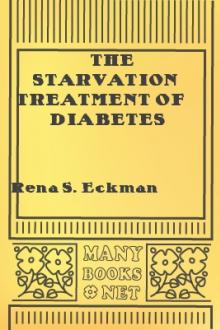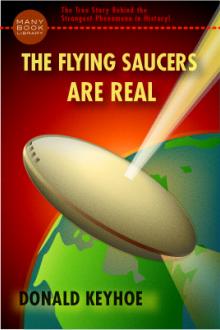Appendicitis by John H. Tilden (life books to read txt) 📕

- Author: John H. Tilden
- Performer: -
Book online «Appendicitis by John H. Tilden (life books to read txt) 📕». Author John H. Tilden
The inflammation of the cecum and appendix is similar to inflammations elsewhere; the capillary blood vessels become engorged, the circulation becomes sluggish, and this causes swelling; the tissues then grow dark from the congestion. This condition is similar to tumefaction in general. which is favorable to abscess formation.
When the local irritation and inflammation start with enough impetus to evolve an abscess the parts become fixed, as stated above, and the environing structures assume an attitude of alligated defense. There is a drawing together of neighboring tissue; the momentum, which should be recognized as the brood mother and care-taker of everything vital in the abdominal cavity, joins with contiguous structures and all become welded together by a friendly adhesive inflammation. When this defense is complete the abscess is walled in so completely and with such thoroughness that all possibility of intraperitoneal rupture rests with the blundering, heavy-handed, trouble-hunting profession; and if nature ever fails to complete the building of this wall of defense it will be because she has been interfered with by officious meddling in the name of scientific healing.
There is no question but that many of these patients are seriously handicapped and others positively killed by unskillful, overzealous, superfluous examinations. A heavy-handed attendant should never be allowed to manipulate swellings in the right iliac fossa, nor in any other suspected region, for fear of destroying nature’s defenses, and possibly rupturing an abscess, the contents of which will be emptied into the peritoneal cavity, causing peritonitis and death.
Seeds are seldom found in the appendix and the fear of swallowing them because they may lodge in it is not well founded. There is no question but that this organ has the power, when normal, of taking care of itself. It has a peristaltic action and can expel anything that is capable of gaining entrance.
Symptoms: An acute attack is ushered in with severe pain. At first this is felt over the entire abdomen, but it is more marked near the navel than elsewhere. After about twenty-four hours it becomes localized in the region of the cecum.
The pain is colicky or spasmodic in character, showing that it is due to peristalsis; food of any kind increases the peristalsis; hence the pain becomes more severe after feeding. Do not make the mistake of thinking that liquid food, such as milk, can be given, for a teaspoonful is sometimes sufficient to make the patient miserable for a whole day.
The abdomen is tender, especially over the cecum, and should therefore be manipulated as little as possible, for it causes the patient unnecessary pain, and if an abscess has formed there is danger of breaking the walls which nature has thrown up.
Nature’s tendency appears to be to fix the inflamed portion so as to secure rest and this is accomplished by the muscles of the abdominal wall becoming rigid, especially over the cecum. These muscles are contracted to such an extent that the right thigh is often drawn up in order to relieve the tension.
When the cecum is inflamed it is common for the colon to be loaded; this colon obstruction prevents the onward passage of the contents of the small intestine, and when they cannot free themselves and the peristaltic movements meet with sufficient obstruction to force a halt, the pain and suffering become intense. When the peristaltic movement has met with a few disappointments it reverses and empties the contents of the small intestine into the stomach. The result is nausea and vomiting which at times are both severe and persistent. But when it lasts beyond three days it is an indication of a complication or mistake in diagnosis, providing the patient has been properly treated.
The abdomen becomes distended with gas if drugs and food are given; as regards the pulse, there is nothing characteristic about the pulse rate and the temperature in this disease. Sometimes the temperature does not go over 100 degree F., but at times it reaches 105 F. The pulse is sometimes so rapid that it is hard to count—due usually to drug influence—and again it may not go above 100 or 110 beats per minute during the entire attack.
As these patients are nearly always constipated, and suffering from indigestion, they generally have a coated tongue.
The above symptoms are those relied upon in making a diagnosis, and especially the first four—pain, tenderness, rigidity, and nausea with vomiting—which are generally referred to as the four cardinal symptoms. Some authors give a “characteristic triad,” namely: pain with tenderness of the abdominal wall, fever, and vomiting.
A patient may have pain with tenderness, fever and vomiting, and be very far from having appendicitis. There is a world of difference in the importance of pain, the range being from no danger at all to absolutely no hope. Tympanites may mean a very simple state or an absolutely hopeless state. To be able to interpret the exact worth of symptoms means observation, study, reflection—labor and experience running over years—and a love of work that is not the good fortune of a very large percentage of mankind.
Before we get through with this subject the reader will be shown how it is possible for highly educated men to be wholly unable to interpret the worth of symptoms.
Surgical Treatment: Appendicitis is quite generally thought of as an exclusively surgical disease. Osler recommends that such cases be operated upon, and most of the prominent physicians agree with him. The surgeons are a unit for the operative treatment.
Many surgeons are in accord with Prof. L. ID. Russell of Cincinnati, O., namely, that it is not a question of “when to operate, but how much to operate,” meaning that all cases should be operated upon as soon as possible after the diagnosis has been made, but the extent of the operation is to be decided by the conditions found after the incision has been made. If the appendix is surrounded with pus and hard to get at, the indication is merely for drainage at this operation, but if the appendix is accessible, it should be removed.
Ochsner recommends the withdrawal of all food by mouth, washing out the stomach, leeches to be applied on the abdomen over the inflammation to relieve pain, rectal feeding, and operation in every case after the acute attack is over. If a “competent surgeon” is available he thinks the proper thing to do is to operate during the acute attack, except in a class of very severe cases, which, he says, have a better chance to recover without the operation. I will quote a few paragraphs from his book, setting forth his views:
“Taking into consideration the pathological conditions described, together with the clinical experience, the likelihood of a recurrence after an attack if no operation is performed, and the likelihood of a complete and permanent recovery if the diseased organ is removed under favorable circumstances, we can come to but one conclusion, namely, that if the desired condition can be obtained the diseased appendix should be removed.”
“Except in very rare cases in which the entire mucous membrane of the appendix is destroyed during the first attack, it is doubtful whether the patient ever completely recovers unless the appendix be removed. It is more likely, from an anatomical and pathological standpoint, and certainly more in accordance with my clinical observations, that the patient usually suffers from disturbance of his digestive apparatus after recovering from an acute attack of appendicitis.”
” Mynter does not deny the possibility of complete recovery from appendicitis without removing the organ, but considers it an exception or almost an impossibility, and I find that this view is shared by a majority of clinical observers of wide experience.”
“It is rare for an acute attack of appendicitis to subside unoperated without leaving one or more of the pathological conditions briefly described above, and it is plain that with these present the patient must be much more liable to a future attack than he was primarily. In fact, many of the best observers with the largest experience think that recurrence in these cases is the rule and complete recovery the rare exception.”
[The pathological conditions referred to are ulcerated or gangrened appendix, perforations, fecal concretions in the appendix, etc.]
“It does not matter whether the patient suffers from catarrhal appendicitis, with or without a foreign body in the appendix, or whether the appendix be gangrenous or perforated, he will almost invariably recover if from the beginning of the disease absolutely no food is given by mouth.”
“Some years ago, before I had learned to appreciate the treatment which I now describe, I frequently operated upon patients in just this condition, [condition of patient described as having temperature of 104 degree F., pulse 140, abdomen very much distended, features pinched and patient delirious], as a last resort, thinking that this gave them the only possible chance of recovery. Since then I have learned that this case belonged to a class which practically never recovered after an operation, if it is done while the condition is that in which I found this patient, and of which a very large majority recover if the treatment is followed which I have described.”
[The treatment referred to is to let the patient alone except giving food by rectum.]
“I have had an opportunity to observe a very large number of these patients under this form of treatment, and have operated upon many of them at various intervals after the acute attack through which they were treated in this manner, and have been able to demonstrate that the patient can recover, and practically always does recover, if this method of treatment is employed. Of course, one occasionally encounters a patient suffering from appendicitis who is in a dying condition, and then neither this nor any other method is of any value.”
“I find that many authors advise rectal feeding under certain conditions, but I am certain that the exclusive rectal alimentation is of greater importance in the treatment of appendicitis than any other single method, but I am equally certain that it must be carried out thoroughly, because even a small amount of food or the administration of a cathartic may suffice to bring about a fatal issue.”
[Why feed! There is no danger of starving!]
“I am also certain that many patients are enormously benefited by the use of gastric ravage for the purpose of removing a quantity of decomposing material, the absorption of which would certainly do a great amount of harm. I am also certain that gastric lavage does permanent good only if no further food is placed into the stomach, which would result in further decomposition.”
[At the beginning of treatment—the first visit—wash the stomach and then feed no more.
Although some physicians boast that this is an age of preventive medicine, the following paragraph is about all that is devoted to this phase of the subject. In one or two places people are cautioned not to eat too much and chew thoroughly, but what does this amount to? How many people know how much to eat or how thoroughly to chew? Very few physicians have a grasp of this subject.]
“It is true that recurrences can usually be prevented by careful attention to diet, by securing daily free evacuations of the bowels, by avoiding overwork and above all things by abstaining from eating too freely, especially of indigestible food when tired. Notwithstanding these facts most patients will never be entirely well after recovering from an attack of appendicitis, and if this is the case I believe that the best treatment consists in the removal of the diseased appendix.”
“In conclusion





Comments (0)